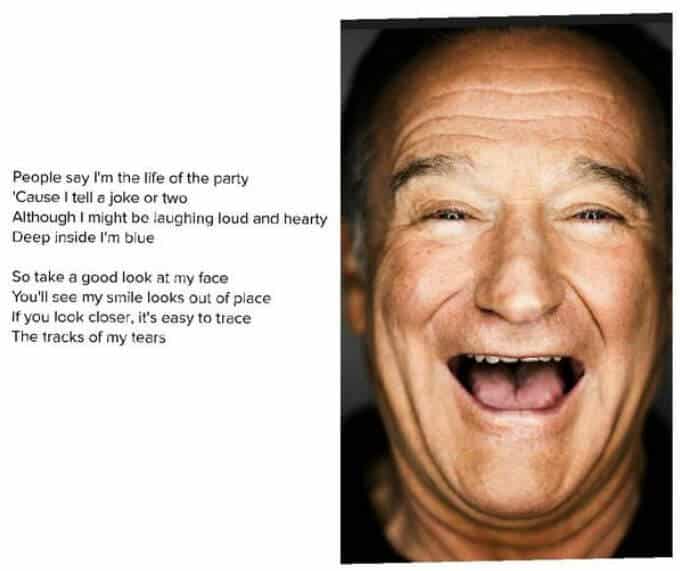Smiling Depression, are you smiling on the outside but struggling on the inside?
by Dr. William Anixter, MD, Psychiatrist at CooperRiis
“People say I’m the life of the party ’cause I tell a joke or two. Although I might be laughing loud and hearty, deep inside I’m blue.”
-Smokey Robinson
Smiling depression is something we have all heard about. Smokey Robinson told us about it in the 60’s with the lyrics above. Nat King Cole told us in the 50’s that it was a way to cope. ‘Smile though your heart is aching, smile even though it’s breaking. When there are clouds in the sky, you’ll get by.’

What does it look like?
In the mental health field smiling depression refers to someone who is struggling with the illness of depression while presenting a smiling face to the world. While this is not uncommon behavior, it is not an actual psychiatric diagnosis. Utilizing current diagnostic criteria, we would refer to it as Major Depression with Atypical Features.
It can be as serious and at times more dangerous than the more commonly encountered forms of depression. There are several reasons for this.
First, maintaining a ‘happy face’ for the world while feeling despair and hopelessness inside takes a great deal of psychic effort and energy. Depression is an illness that does not take place over a few days, so hiding it week after week is exhausting.
It also interferes with the persons ability to be honest about how they feel with friends and family, further contributing to isolation, loneliness and suicidal despair. At times, those involved in the person’s life might be fooled and may not reach out to help as they might otherwise.
Who does it affect?
A person with smiling depression is likely to be experiencing many of the other symptoms of the illness. Changes in sleep patterns, changes in appetite, feeling of hopelessness, guilt, low self-esteem, anxiety, poor concentration, unexplained physical problems, like pain, headaches, or eating problems, decreased interest in sexual intimacy and loss of ability to enjoy traditionally pleasurable activities, as well as suicidal thoughts or impulses.
We might see this person functioning at work or school, then rushing home, avoiding friends, making excuses to isolate socially, not eating, losing weight, expressing irritability that they have tried to hide during the day. They often show less interest in others and don’t keep up with their hobbies or projects.
And why?
There are a variety of causes for this behavior. Some people have been taught to hide their emotions, “big men don’t cry”. Others feel that appearing depressed will burden the people around them. Some people are afraid that appearing sad will lead to personal or professional consequences. This seems especially true in the age of social media, as so many people see and comment on one’s appearance. Others were raised in settings where feeling down was responded to with ridicule or rejection. They may fear that same happening again. Some people are just embarrassed or ashamed to have these problems. Others attempt to utilize Nat King Cole’s advice. They figure if they deny how they feel and act happy, the problem will disappear. These motivations can be either conscious or unconscious. Something they are aware of and do purposefully, or something buried in past experiences.
Risk factors will include traditional reasons like conflict, loss, grief or stress. These can seem worse by living in social settings where being down can impact social or professional status or goals. Another common aspect of depression is where the outward physical attributes of sadness are misread by others. They may feel that the depressed person is angry or upset with them.
Is there help?
When these sorts of behaviors have worn the person out or damaged important relationships, it is time to get help. When the person exhibits unexpected angry outbursts, frequent anxiety, or experiences thoughts of suicide, it is time to find a therapist.
This might be harder to do if you have convinced those close to you that nothing is wrong, but it is likely that they are already aware that there is a problem. It is not easy to wear that smiling mask all day.
Mental health professionals have a number of approaches that can help. Forming a trusting connection with someone to whom you can reveal your true feelings is a big first step in breaking the prison of social disconnection and isolation. Commonly used techniques include interpersonal therapy – focusing on improving communication and relationships, cognitive therapy – focusing on identifying and modifying distorted thought patterns that perpetuate negative feelings about oneself, the world and the future.
There are also several highly effective meditations which can help treat the low mood, improve sleep patterns and control anxiety.
If you find yourself feeling like Tony Soprano, having to be ‘the sad clown, laughing on the outside, crying on the inside’, by all means reach out to your doctor, a trusted teacher or mentor, a supportive friend or family member and let them know you need help. This is a treatable situation and you do not need to suffer and struggle alone.
For additional information: ‘If you fake a cheerful or happy mood to hide inner despair, you could have smiling depression.’ at https://www.insider.com/guides/health/mental-health/smiling-depression









